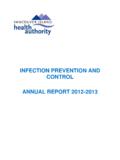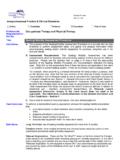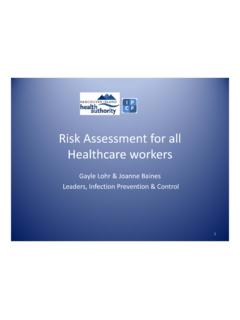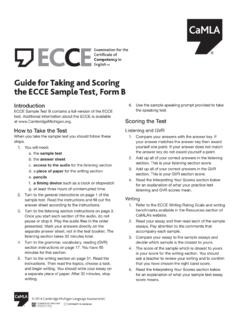Transcription of Before, During and After Your Cataract Surgery - …
1 01-77-0683-0 (Rev 05/12) May 2012 Before, During and After your Cataract Surgery A guide for adults having Cataract Surgery at the Royal Jubilee Hospital. Please: Read this booklet the day you get it. Keep it beside your phone to write down any further instructions. Bring it to all your appointments before and After your Surgery and to the hospital the day of your Surgery . your name: _____ Before, During and After your Cataract Surgery Page - 2 Introduction This booklet was written for people having Surgery to remove cataracts from their eye(s). People who are prepared for Surgery and who take part in their care can recover in less time and with fewer complications. This booklet will give you the information you need to get yourself, your family and your home ready for Surgery . If you have any questions regarding your Surgery , please contact your surgeon s office. You can learn more about preparing for your eye Surgery at *IMPORTANT: The information in this booklet is intended solely for the person to whom it was given by the health care team.
2 It does not replace the advice or directions provided to you by your surgeon. Approved by: Division of Ophthalmology, VIHA South Island Before, During and After your Cataract Surgery Page - 3 Table of Contents Introduction .. 2 About Cataract Surgery .. 5 What is a Cataract ? .. 5 What causes cataracts? .. 5 Why are Cataract removed? .. 6 Types of Cataract Surgery .. 6 Types of intraocular lenses (IOLs) .. 7 How well does Cataract Surgery work? .. 7 Risks .. 8 Making a decision about Cataract Surgery .. 9 Getting Ready For Surgery .. 10 Preoperative history and physical exam .. 10 Cancellations .. 10 What to do if you are not feeling well .. 10 Preadmission Clinic (PAC) .. 10 Pay for your lens implant .. 10 Arrange for a ride .. 11 Eating and drinking before Surgery .. 11 Medications .. 11 Supplies and eye drops .. 12 How to instill eye drops .. 13 Before, During and After your Cataract Surgery Page - 4 What to bring to hospital.
3 14 What NOT to bring or wear .. 14 Check-in procedure .. 15 What to expect .. 16 Going Home .. 17 What to expect After Cataract Surgery .. 17 Care at home .. 18 Bathing .. 18 Care of your eye .. 18 Activity .. 19 Healthy eating .. 20 Going to the bathroom .. 20 Medications .. 20 Call your surgeon if you .. 21 Follow-up 21 Tell us what you think! .. 23 Before, During and After your Cataract Surgery Page - 5 About Cataract Surgery What is a Cataract ? A Cataract is a painless, cloudy area in the lens of the eye. The lens is located behind the iris and is normally clear. Light passes through the pupil, the dark area in the centre of the iris, to the lens. Because cataracts block this light, they can cause vision problems. Illustration copyright 2000 by Nucleus Communications, Inc. All rights reserved. What causes cataracts? There is no way to prevent cataracts, but they can be caused by: Natural changes to the eye due to the aging process Trauma to the eye Some medications or toxic chemicals Birth defects Before, During and After your Cataract Surgery Page - 6 Why are Cataract removed?
4 The purpose of Cataract Surgery is to remove the clouded lens of the eye (the Cataract ) to improve sight. The lens can be replaced with an artificial lens called an intraocular lens implant (IOL). Or, if an IOL cannot be used, it will be left out and contact lenses or, rarely, strong eyeglasses can make up for it. Most patients will get an IOL During Surgery . Most Cataract Surgery is done as day Surgery using a topical anesthetic (eyedrops). Some patients will also need a sedative to help them relax. Patients with extreme anxiety, certain medical conditions and children usually need a general anesthetic. Types of Cataract Surgery There are two types of Cataract Surgery with lens implantation. The decision about which Surgery to have depends on you and your surgeon. You may also choose to not have Surgery and continue with your present state of vision. 1. Phacoemulsification: In this type of Surgery , the incisions are small and sound waves (ultrasound) are used to break up the lens into small pieces.
5 This is the most common way to do Cataract Surgery . You can see a slide show on this type of Surgery at and search Cataract Surgery . 2. Extracapsular Surgery : In this type of Surgery , the lens and the front part of the lens capsule is opened. The lens is then removed in one piece. Sometimes a small incision is used and Before, During and After your Cataract Surgery Page - 7 the lens is broken into small pieces. Extracapsular Surgery is also called extracapsular Cataract extraction, or ecce . ecce is rarely done these days. Intraocular lenses (IOLs) There are different types of intraocular lenses (IOLs) that are placed inside the eye During Cataract surgeries: the soft foldable lens or the specialty vision correction lens. The foldable intraocular lens is the standard and most commonly used type. By folding the lens, it is possible to insert it through a small incision. Once inside the eye, the foldable lens unfolds right away and gives excellent vision.
6 The major benefit of a foldable lens is in the smaller incision, which heals quickly. Also, clouding of the clear membrane behind the lens happens less often. The foldable lens is covered by the Medical Services Plan of BC. Specialty vision correction lens must be ordered by your surgeon and paid for on the day of Surgery . Ask your surgeon for payment information. If you have extended health insurance, you will need to arrange repayment with them After Surgery . How well does Cataract Surgery work? Cataract Surgery has an 85% to 92% success rate in adults with few complications and little to no discomfort. Before, During and After your Cataract Surgery Page - 8 Risks Less than 5% of people have complications from Cataract Surgery that could threaten their sight or require more Surgery . The rate of complications increases in people who have other eye diseases as well as the Cataract . Although the risk is low, Surgery for cataracts does involve the risk of partial to total vision loss.
7 Some complications can be treated and vision loss reversed, but others cannot. Potential complications that may occur with Cataract Surgery include: Infection in the eye (endophthalmitis) Swelling and fluid in the centre of the nerve layer (cystoid macular edema) Swelling of the clear covering of the eye (corneal edema) Bleeding in the front of the eye (hyphema) Bursting (rupture) of the capsule and loss of fluid (vitreous gel) in the eye Detachment of the nerve layer at the back of the eye (retinal detachment) Complications that may occur sometime After Surgery include: Problems with glare Dislocated intraocular lens Before, During and After your Cataract Surgery Page - 9 Clouding of the portion of the lens covering (capsule) that remains After Surgery , often called After Cataract . This is can be treated with laser Surgery , if needed. The type of IOL may affect how likely it is to have clouding After Surgery . Retinal detachment Glaucoma Astigmatism or strabismus Sagging of the upper eyelid (ptosis) People usually need reading glasses After Cataract Surgery no matter which type of Surgery is performed.
8 Many will still need glasses for distance vision. Usually, vision is retested about 6 weeks After Surgery and new glasses are prescribed. your surgeon will give you instructions After your Surgery . Making a decision about Cataract Surgery Cataracts: Should I Have Surgery ? is a decision tool, that along with your surgeon, can help you make a decision about having Cataract Surgery . The decision tool can be found on the HealthLinkBC website at: . Before, During and After your Cataract Surgery Page - 10 Getting Ready For Surgery Preoperative History and Physical Exam You must have a Preoperative Physical with your family doctor between 3 weeks and 6 months of your Surgery . If you do not have a family doctor, go to a walk-in clinic to have this done. Cancellations Please let your surgeon s office know if you need to cancel. If you cancel 3 times, the hospital will return your request for Surgery and we will need to start the process from the beginning.
9 What to do if you are not feeling well If you are not feeling well in the week before your Surgery , please contact your surgeon s office at once if you: Are not feeling well Have a cough, cold or fever Develop unusual redness or discharge from your eye Have been in contact with someone who has an infectious disease measles, chicken pox, tuberculosis, antibiotic resistant organism (ARO) Preadmission Clinic (PAC) PAC phones all patients within the week before Surgery . They will tell you if you need any tests and how to get them done. Before, During and After your Cataract Surgery Page - 11 Arrange for a ride Before coming to hospital, please arrange to have a responsible person to: Bring you to and from the hospital (by car or taxi). You will not be allowed to drive yourself or take a bus. Stay at the clinic During your stay and for at least 24 hours After Surgery , if possible. Help you with daily activities as needed and to follow post-op instructions.
10 If you do not arrange to have a responsible person to take you home and stay with you overnight, your Surgery may be postponed until you are able to make these plans. Eating and drinking before Surgery You are encouraged to eat your regular meals and fluids before coming to hospital. Please do not fast! Medications Take all your regular medications, including diabetic medication, on the day of your Surgery unless told otherwise by your surgeon. If you are currently using eye drops, ask your surgeon for specific directions about stopping these before Surgery . Before, During and After your Cataract Surgery Page - 12 Supplies and eye drops Buy a roll of 1/2 inch wide, non allergenic medical tape to tape your eye shield in place After Surgery . Make sure you have some plain acetaminophen (Tylenol ) at home to take if you have any discomfort After Surgery . Make sure you have some 70% isopropyl alcohol to clean your eye shield After Surgery .









